

What Do They Know: Goldman, Amex Quietly Cut Rates On Savings Accounts… Is The Fed Next?
It is not a secret that the biggest market debate of 2024 is when – and even if – the Fed will cut rates: after all, with the US labor force adding hundreds of thousands of illegal immigrants, and core CPI bubbling along at a blistering hot ~4% pace, many – such as Larry Sanders and even Neel Kashkari – are warning that the Fed does not need to cut rates (in fact, a rate hike may be prudent). On the other hand, we have a growing roster of Democrat politicians (most notably Senator Elizabeth „Pokarenhontas” Warren) demanding Powell cuts rates to „help address the affordable housing crisis” and also reduce the record high credit card APRs for their voters.
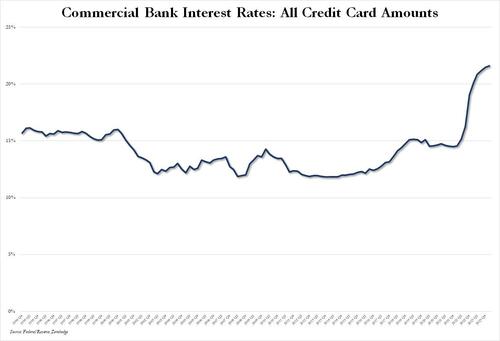
It’s not just the politicians: the dovish Fed itself in its latest dot plot indicated that it still expects to cut rates 3 times in 2024, a schedule which – when accounting for the November elections – would mean the Fed has to start cutting in June if it wishes to avoid delaying the start of the easing cycle and also avoid the impression that it is hoping to influence the outcome of the presidential elections (much to the chagrin of Bill Dudley who wrote a 2019 op-ed demanding Powell do just that).
Yet even as the market has recently taken a machete to its own dovish expectations, and after pricing in more than 6 rate cuts in 2024 at the start of the year, has since trimmed its forecast to less than 3 full cuts…
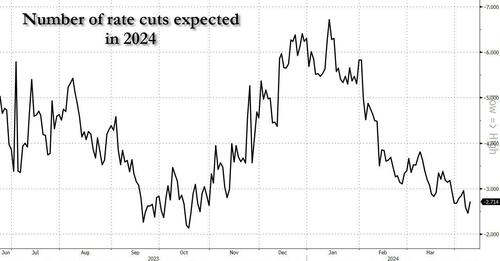
… or even fewer than the Fed has telegraphed…
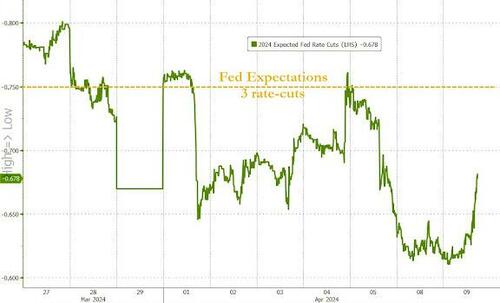
… suggesting that the market is convinced that the Fed is wrong, the economy will run hotter than expected, and Powell will be forced to delay, or even scrap, the easing cycle.
But maybe not, because while signs mounts – especially in the realm of higher commodity prices – that a June cut is a pipe dream, some financial institutions are aggressively taking matters into their own hands: consider that in the last week, not one but two financial giants, have quietly cut the interest rate they pay on their „high yield” savings accounts, a step that usually takes place just around the time they are dead certain the Fed will cut rates or right after.
We are talking about Goldman and American Express: starting with the former, last Wednesday, Goldman’s consumer bank Marcus lowered the rate on its high-yield savings account for the first time in more than three years, trimming the APR on the bank’s flagship product to 4.4%, down from 4.5% in March. It was the first cut since November 2020, when Goldman lowered the rate from 0.6% to 0.5%.
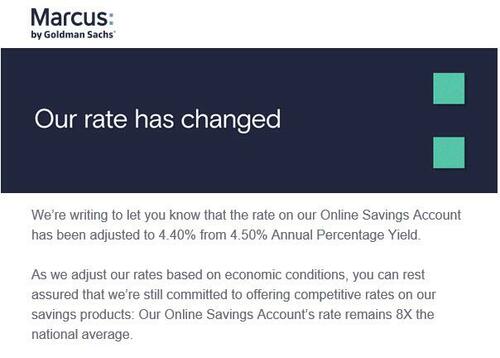
“Our current rate places us ahead of the majority of our peers,” a Goldman spokesperson told Bloomberg in an email when asked to explain the rate cut. “We will continue to focus on providing value to our customers and growing our Marcus deposits business which is a priority for the firm.”
Well, you can only keep growing deposits if the rate cut does not lead to deposit outflows… which can only happen if Goldman knows that everyone else is also about to cut rates, following in the footsteps of the Fed
And then moments ago, doubling down on the clear dovish trend that is suddenly sweeping banks for „reasons unknown”, American Express did the same, when it cut the rate on its High Yield Savings Account to 4.30% from 4.35%.
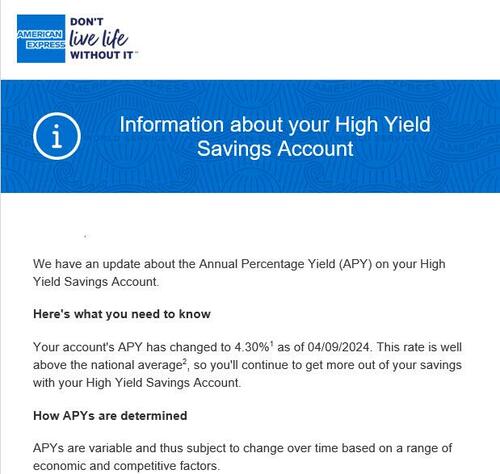
Or maybe the cuts are not for „reasons unknown”: maybe the banks realize that they can start cutting rates because soon everyone else will do the same for one simple reason: the Fed will fire the starting pistol to an easing cycle so many believe will start momentarily.
As Bloomberg notes, the move signals that financial institutions are on alert for when they can lower interest rates for individuals, and the fact that not one but two of the biggest players in the game just did that, should be enough to raise a lot of eyebrows about the Fed’s rate cutting plans…
Tyler Durden
Tue, 04/09/2024 – 11:30

 1 rok temu
1 rok temu
![Dziedziczenie traum. Sylwia Góra rozmawia z Tatianą Țîbuleac [WYWIAD]](https://kulturaliberalna.pl/wp-content/uploads/2025/10/tatiana_wywiad_ikona.jpg)











